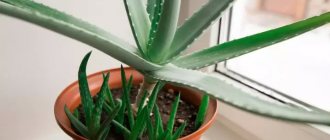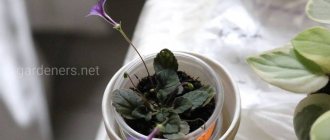Violet or Saintpaulia is an elegant and delicate flower that requires special care and attention. One of the important conditions for growing a healthy flower is replanting.
To preserve its decorative qualities and ensure its full development, the plant should be replanted in a timely and correct manner. Let's take a step-by-step look at how to transplant Saintpaulia yourself and without mistakes .
When should a violet be replanted?
Several factors indicate the need to replant the plant:
- A white coating appears on the ground. This indicates that the soil has poor air permeability. Also, the presence of a white coating indicates oversaturation of the soil with minerals. As a result, the roots begin to rot and the plant loses its attractiveness.
- The root ball grows too much and is visible on the surface of the soil, under the leaves. This interferes with the growth and development of the flower.
- The soil is depleted , has become dense, and the plant does not receive any nutrition.
- Violet leaves turn brown ; fertilizing does not help.
- The plant has grown and part of the bare stem has appeared. The transplanted flower will be more magnificent and beautiful.
- New “babies” have appeared that need to be separated from the mother’s outlet.
The appearance of any of these signs indicates that it is time to change the Saintpaulia container.
In this video you will be told about the importance of replanting violets with changing soil.
How to prepare your own soil mixture?
If you decide to make your own primer, study the composition that is needed for different cases. For example, in the case of wick irrigation, special requirements will be placed on the soil.
For wick irrigation
We have already determined what kind of soil violets like, but we will not forget to repeat that the soil used for wick watering should:
- have high friability;
- good air flow;
- retain moisture.
Therefore, it is worth enriching the purchased mixture with vermiculite, agroperlite, and sphagnum moss.
Disinfection
The ready-made store-bought mixture is completely sterilized before sale, so it does not require disinfection, but you can add a little crushed charcoal to it.
If you collected the soil yourself, it needs to be calcined in the oven for several hours.
Transfer time
For violets to take root better, spring is . At this time of year, the plant has enough natural light, and the temperature for transplantation is optimal. As a result, Saintpaulia will tolerate a change of “place of residence” well.
September and October are also recommended for replanting capricious violets into new pots. In the summer heat, it is undesirable to touch the plant . At high temperatures, the transplant will cause him unnecessary stress. The same applies to the winter period. Due to a lack of sun and uncomfortable temperatures, the plant may not take root and die.
Optimal conditions for the transplantation procedure are ten-hour daylight hours and a temperature of +18 degrees . If you still need to replant Saintpaulia in winter, you need to install special lamps for additional lighting and ensure the required level of humidity in the room.
Beginning flower growers often ask whether it is possible to replant a blooming violet. Transplanting Saintpaulia during flowering is resorted to only in emergency cases .
If a plant is exposed to a disease or is attacked by pests, it must be replanted immediately, regardless of flowering or time of year. The violet is also replanted if it is too flooded , which can cause the roots to rot.
Important! After transplantation, flowers or buds should be removed so that the plant directs all its energy to rooting and not to flowering.
Under normal conditions, the flower is not touched during the budding period. Flowering indicates the plant is in good health. Since it blooms, it has enough nutrients. Therefore, replanting can be delayed until flowering is complete.
Some gardeners rely on the lunar calendar for transplanting violets. It indicates favorable periods for planting, down to the day.
Caring for violets in spring, summer, autumn, winter
Caring for violets
As for care in spring, summer and autumn, it is quite standard. All that will be required of you is to regularly water the flower and do not forget to fertilize. If you do all this on time, then the violet will definitely delight you with its bright appearance. But with the arrival of winter, violet care becomes a little different.
First, you must make sure that she receives the right amount of light throughout the day. Therefore, it will be better if you move it to the sunny side or try to turn on the room lighting immediately after it starts to get dark. Secondly, during this period it is necessary to strictly monitor the humidity and temperature in the room. If these indicators are very low, the flower will probably die.
It is also worth remembering that violets do not need to be fed in winter. You can quite easily carry out the last fertilizing in November, and the next time you add nutrients to the soil at the beginning of March. During the dormant period, the violet will rejuvenate and with the arrival of spring it will begin to delight you with a large number of bright flowers.
Transplanting violets after purchase
After purchasing a violet, you need to carefully inspect it, remove dried buds, flower stalks and leaves. Store-bought flower pots usually contain a peat mixture that contains no nutrients. Therefore, after purchase, the plant should be replanted as soon as possible .
To do this, prepare a new substrate by mixing high-moor peat with vermiculite. This mixture will be moderately sour and loose. If you wish, you can purchase ready-made soil for violets .
After transplantation, the plant is covered with film to obtain a greenhouse effect . After 7 – 10 days, the film can be removed.
If the flower was purchased not in a store, but from familiar flower growers, you don’t have to rush to change the pot. In this case, the young plant is not immediately replanted, giving it time to develop the root system.
Preparing to plant violets
To plant violets at home, you will need a good flower pot. It is best to plant violets in round, almost flat pots. They should not be deep, because the root system of the plant is close to the surface of the soil, and does not grow downward, but to the sides. The main rule when choosing a pot is that it should be 3 times smaller in diameter than the violet rosette.
Only in this case will you be able to enjoy succulent leaves and beautiful flowering. Plastic disposable cups or cut-off small bottles. They will be useful for rooting the plant. Purchase a ready-made soil mixture that will be used for planting. Many stores sell it ready-made. The soil must be loose, light and well saturated with air.
But, some plant lovers want to control everything themselves, so you can prepare it yourself. In this case, you should prepare all the components. For this you will need turf soil, coniferous and leaf humus, peat, and fine river sand. Complex fertilizers that are useful for feeding the plant.
As soon as you prepare the soil, you must immediately add superphosphate to it as a fertilizer. After this, you need to feed the plant when buds form, and after flowering itself.
If planting occurs in winter, you also need to prepare a fluorescent lamp with which you will illuminate the young flower so that it does not feel a lack of light. To do this, fix the lamp at a distance of 20-25 cm from the plant and illuminate it for 10-12 hours. Having gone through such simple preparation for planting the plant, the procedure will be simple and easy.
How often to replant
In flowering perennials, the root system develops quickly . The plant quickly draws all the nutrients from the soil, and it becomes depleted. The roots begin to peek out of the drainage holes or above the ground. The violet needs to be replanted at least once every 7–8 months.
Timely transplantation of Saintpaulia into a new pot will help prevent diseases , and the violet itself will delight with beautiful flowering.
Methods of growing in soilless soil: pros and cons
When studying the question of which land to choose for growing violets, some gardeners settle on the landless option. This mixture is based on peat or coconut substrate with the addition of raising agents.
Coconut substrate.
It is distinguished by a complete lack of nutrients , which are introduced independently with the help of fertilizers. It is often used for wick growing of Saintpaulia.
The advantages include the complete absence of pathogens. But due to the lack of nutrients, they must be constantly supplied from the outside, so this method is only suitable for wick irrigation.
How to choose a pot
Shallow pots are chosen for relocating Saintpaulias , since the roots of these flowers develop from the bottom up. A height of 10 cm and a diameter of 9 cm will be sufficient. If the plant is planted in a larger pot, it will intensively develop roots and entangle the earthen ball, and there will be no strength left for flowering.
A pot made of clay or plastic is suitable for violets . A clay pot provides good air permeability and maintains soil moisture at the roots. In such a pot, the plant is less likely to get sick and be attacked by pests. The downside of these pots is that they are heavy and not cheap.
A plastic flower pot is lightweight and easy to care for. Its disadvantage is poor air circulation. To fix this, holes are made with a nail in the bottom and side walls.
In this video they will show and tell you what pots and soil to plant violets in.
Popular varieties for home growing
Today, violet takes pride of place on windowsills and in the hearts of flower growers around the world. There are entire clubs of lovers of these flowers , which breed a huge number of varieties and hybrids.
The whole set of Saintpaulias can be divided into groups:
- industrial. Designed for mass breeding. The least whimsical of all. They bloom for a long time. Ideal for beginners;
- collectible. They have large, often double, inflorescences of various colors and shades. Requires a lot of effort and increased attention;
- variegated. They are distinguished by their unusual leaf color.
Not too capricious varieties of the industrial group are suitable for growing on a windowsill. They tolerate some lack of light and moisture, forgive beginners agrotechnical mistakes, and bloom magnificently and for a long time. Among them:
- Currant dessert. Fluffy, semi-double flowers are star-shaped;
Currant dessert.
- Alice Blizzard Baths . A very popular variety among hobbyists with heart-shaped leaves and white semi-double flowers;
Alice Blizzard Baths.
- Marquise . It has large double inflorescences of rich pink color with a lilac border around the edge;
Marquise.
- Lilac beauty . Even a child can handle caring for this variety;
Lilac beauty.
- Blue Lagoon . Blooms for a long time, easy to care for;
Blue Lagoon.
- A gift for a loved one. The leaves have a pink-white edge. Inflorescences are blue.
A gift for a loved one.
A wide variety of types and varieties of Saintpaulia allows each gardener to choose pets, focusing on their preferences and capabilities.
What soil to plant violets in
To independently prepare soil that is best suited for violets , you will need the following components in equal parts:
- two parts of leaf soil;
- part of coniferous soil;
- part of the peat;
- part of the turf land;
- some river sand;
- a handful of charcoal.
Advice! For better results, vermicompost can be added to the soil 2 weeks before transplanting.
The prepared substrate must be disinfected. To do this, it is steamed in the oven or doused with boiling water. After the soil has cooled, you can begin replanting the Saintpaulias.
Indoor violets: propagation by leaf step by step
Violets: propagation by leaf
If you decide to propagate a violet yourself, then the first thing you need to do is find a healthy and strong leaf, which will subsequently become a new flower. It is best to take it from an adult plant that grows well and does not suffer from anything. It is advisable to cut it off in the second row of leaves or under a flowering rosette.
But those leaves that are at the very top or bottom of the flower are not suitable for replanting. The lower leaves are not suitable for these purposes because they are susceptible to rotting, and the uppermost ones, as a rule, are not yet developed enough to take root successfully.
Recommendations for propagating violets:
- Carefully pinch off a leaf from an adult violet and carefully examine it from all sides. Be sure to check that there are no stains or damage on it.
- The next step will be to prepare the sheet. To do this, you will need to take a sharp knife and cut its stem at an angle of 45 degrees. Such manipulation will increase the area on which roots will begin to form, which will subsequently allow the formation of a fairly powerful root system.
- Then prepare a bowl into which you will place the leaves. It will be better if these are containers with a thin neck. If you don’t have anything like that, then take an ordinary plastic cup, just don’t put the leaf in it without a paper lid with a slot.
- Next, dissolve activated carbon in water and pour the resulting liquid into prepared containers. If you do not want to prepare such a solution, then mix distilled and ordinary water in equal parts. In this case, you will also have a weakly disinfected environment with a minimum number of microorganisms.
- Pour disinfected water into containers and place pre-prepared violet leaves into them. If you want to avoid rotting, then make sure that their stem goes no more than 1 centimeter into the water.
- Place containers with leaves in a place where there is enough light during the day, but make sure that they are not exposed to direct sunlight during the day. Also, do not forget to ensure that the water in the containers always remains at the same level, and if necessary, add it periodically.
- After the leaf has roots, carefully transplant it into the soil. Do everything so that the young roots are not damaged, and under no circumstances push the leaf too deep into the soil. Such actions will only delay the development of a full-fledged plant.
Preparing the plant
Before transplanting a violet, it should be prepared for the procedure . The soil in the pot is moistened so as not to damage the roots of the plant. There is no need to fill the pot with water until dirt forms; the substrate should remain loose.
The violet is carefully removed from the old flowerpot, trying not to stain the leaves. Some of the root shoots are cut off and large leaves are removed . These manipulations activate the rejuvenation of the flower.
Possible diseases
Violet is a capricious plant that is prone to various diseases. The main dangers that can be encountered when growing violets are the following:
- Rosette rotting - occurs when growing conditions are violated (inappropriate soil, excess moisture, watering with cold water and a pot that is too large).
- Powdery mildew parasite - looks like a white coating on leaves and stems. The appearance of these parasites is facilitated by lack of lighting and low air temperature.
- Late blight is a fungus that attacks the root system. Late blight is dangerous because it remains in the soil, therefore, to treat a flower, it is necessary to completely replace the soil and rinse the root under running water.
- Aphids and mites also spoil the aesthetic appearance of the plant and can lead to its death. Treatment occurs with special solutions purchased in stores.
We wrote in more detail about all diseases and pests of violets here.
Although the violet is a finicky flower to care for, it will not be difficult for experienced gardeners to grow and propagate senoplia. The plant fits well into any interior and can be a wonderful gift for family and friends.
Three methods of transplantation
Depending on the purpose or reason for the procedure, there are three methods , each of which has its own advantages.
Complete substrate replacement
This type of plant replanting is resorted to when the violet stops growing and developing, does not bloom and looks unhealthy . This is a signal that the plant has used all the microelements and the depleted soil can no longer nourish it.
Complete removal of old soil involves cleansing the root system . It is inspected and dried, rotten and damaged parts are removed. As a result, the root part is significantly reduced, and the plant can be planted in a pot of smaller diameter.
Expanded clay is scattered on the bottom as the first layer . Then a small amount of soil is poured on which the violet is laid out, carefully straightening its roots. Next, fill the remaining soil until it comes into contact with the lower leaves. The soil is mulched with vermiculite.
To check whether the soil is well compacted, shake the pot with the plant. compact the soil again .
To maintain soil moisture for the first day, the plant can be covered with plastic film .
This video explains in detail how to properly transplant a violet.
Partial soil replacement
Partial replacement is carried out every time a healthy plant needs to increase the pot . To do this, part of the soil is removed, but the earthen ball around the roots is not touched.
The violet is removed from an old pot in which the soil has been previously moistened. Having transplanted it into a large pot, add the prepared nutrient mixture and tamp it down with a teaspoon.
Transshipment
Transshipment is used when it is necessary to urgently relocate a flowering plant or replace a container that has become cramped with a more spacious one.
The violet is carefully removed from the container along with the earthen lump. Drainage and part of the prepared soil are poured into the new pot. Then the used container is inserted, and the space around it is filled with soil. After this, the unnecessary pot is removed and a flower is placed in its place. All that remains is to carefully level and compact the earth.
brief information
The familiar pansies are grown in the garden as an annual or biennial. But the horned violet is a perennial garden plant; it tolerates winter conditions well even in the middle zone. But in order for the perennial to delight with lush flowering every year, it is necessary to renew the bush every 5 years.
By the way! The interesting name comes from the growth on the back of the flower that looks like a horn.
This beautiful ground cover flower is not only characterized by long-lasting flowering, but is also one of the primroses. That is, such a violet can please with its beauty in early spring! Abundant flowering usually begins in April, May and ends in September.
By the way! Flower crops are able to reproduce independently through self-seeding. If you want to prevent independent reproduction, then you need to pick off the faded flowers before the seeds ripen and, accordingly, fall to the ground.
Horned viola is a low-growing ground cover crop, the height of a compact green bush is about 10-25 centimeters. The rhizome is branched and creeping, so the plant tends to grow actively, the stems form dense cushions, forming a dense colorful carpet.
Up to forty flowers grow on one bush. The diameter of the inflorescence is about 3-5 cm. There are varieties and hybrids with inflorescences of one, two or more shades.
Horned viola can show maximum decorativeness when the growing location is correctly selected: it should be slightly shaded and well ventilated. Prefers slightly acidic soil. Does not tolerate drought and excess water in the soil.
Ideal for border plantings, alpine slides, rockeries, mixborders. It looks interesting as a potted plant, and the pots can be placed both in the garden and on the terrace or balcony.
Can be combined with other ground cover plants, or used for group plantings of the same species. It goes well with small decorative deciduous or coniferous shrubs, with ferns, hostas, heucheras, and bulbous primrose flowers.
How to seat children
It is important to know how to plant young shoots so that they take root. Young rosettes are distributed into pots with a diameter of 6 cm after two pairs of leaves have appeared on them. To prepare the soil, use vermiculite, peat and chopped sphagnum.
The babies are separated from the mother's rosette along with a large leaf. Then they are seated in separate containers at a shallow depth. The soil is moistened , and before rooting, containers with young plants are placed under a lamp.
This video will tell you when it’s time to separate violet babies from the mother leaf and how to do it.
Popular ready-mixes
The assortment of the flower shop is replete with a variety of soil mixtures for Saintpaulias, which have a varied composition. But they are all based on:
- high peat;
- lowland peat;
- baking powder;
- mineral fertilizers.
Let's take a closer look at what kind of soil is good and how flower growers speak about them.
"Flower Happiness" by Fusco
Contains:
- high peat;
- lowland peat;
- river sand;
- dolomite flour;
- complex of mineral fertilizers.
This mixture is a professional quality product , which is packaged in a 2.5 liter bag.
Flower happiness from Fusco.
Reviews about Fusco soil are both positive and negative. The main disadvantage is poor friability. This problem can be solved by independently adding agents that increase looseness.
"Greenworld"
Greenwold soil is completely universal , suitable for all indoor plants, including Saintpaulias. Comprises:
- highland and lowland peat;
- perlite;
- crushed limestone;
- complex of microelements.
Plus, we can note a large range of packaging volumes.
By all indicators, this is the best soil: reviews from collectors about it are mostly only positive. Many people grow plants without adding additional products.
Universal primer Greenwold.
"Bereginya"
Comprises:
- highland and lowland peat;
- river sand;
- dolomite flour;
- complex of mineral fertilizers.
According to reviews, the quality of the product depends on the batch. It can be of very good quality and not so good.
Soil "Bereginya".
"Garden of Miracles for Saintpaulias"
Comprises:
- highland and lowland peat;
- river sand;
- agroperlite;
- vermicompost.
It looks good, there is no excess debris. The soil contains vermicompost, which increases the amount of nutrients and, as a result, improves plant growth.
soil for Saintpaulia "Garden of Miracles".
Has a lot of positive reviews.
"Morris Green"
Contains:
- lowland peat;
- high peat;
- dolomite flour;
- complex of mineral fertilizers.
The absence of leavening agents in the composition reduces air exchange and moisture-holding properties of the soil.
Morris Green.
It has low quality and negative reviews from use.
"Gardens of Aurica"
Contains:
- turf land;
- high peat;
- lowland peat;
- river sand;
- sphagnum moss;
- vermiculite;
- charcoal;
- complex of mineral fertilizers.
"Gardens of Aurica".
A large number of components is an advantage of this substrate.
IMPORTANT! This substrate has a layer-by-layer arrangement of components in a package. You need to pour all the ingredients into a container and mix thoroughly. Re-pour unneeded residues into the bag.
It is inexpensive, has a large number of useful components , so most people respond positively to this mixture.
Care after transplant
To ensure that transplanted plants do not experience stress and recover faster, they need to be helped with proper care . It is necessary to maintain optimal temperature, soil moisture and lighting.
After transplanting the perennial, adhere to the following rules for 2 weeks:
- cover the plant with film ; when condensation forms, remove it for a couple of minutes for ventilation;
- the flower pot is left in a warm place (24 degrees) ;
- Saintpaulias provide sufficient lighting, but protect from direct sunlight .
Can violets be planted outside in summer?
Saintpaulia is an indoor flower. But in summer, violets can be moved into open ground. It should be borne in mind that not all varieties of plants are suitable for planting in a suburban area. Many varieties are sensitive to drafts, low temperatures, and direct rays of the sun.
You can move garden violet (Viola) outside. The variety has special subspecies (annual, perennial), which can be planted in open soil. Planting is carried out using seeds; The material is placed in loose soil with drainage and watered regularly.
Possible errors during transplantation
Knowing how to replant Saintpaulia correctly, you can avoid mistakes and prevent the death of the plant . The most common mistakes made when performing this procedure are:
- The planting depth is chosen incorrectly . Too deep and the roots will rot; too high and the rosette will sway.
- Choose a pot with a large diameter. The plant will not be able to bloom; it will try with all its might to develop the root system.
- The substrate is not prepared correctly . It should not be too dense and oversaturated with nutrients.
- They use soil from greenhouses and greenhouses , which contains pest larvae and fungal spores.
- When watering, water is not poured under the root, but poured into the center of the outlet . This leads to the death of the plant.
This video talks about mistakes when rooting indoor violet cuttings.
Transplanting violets at home requires preparation and
adherence to certain rules .
However, the reward for good care will be a healthy plant that pleases the eye with lush flowering. Read more about when to repot indoor plants here.
Reproduction
To propagate the variety you like, you can use the “from the leaf” planting method.
Recommendations on how to properly plant a violet leaf are as follows:
- a violet leaf, cut from the 2nd or 3rd tier, is placed in a container with water;
- It is advisable to take an opaque container, and the water should be settled or boiled;
- the sheet is strengthened so that it is immersed in water by 1.5-2 cm and does not touch the walls;
- After the roots appear, the small plant is planted in the ground, following the technology.
Planting directly into the soil is preferable. The plant immediately takes root in the pot and does not experience stress during transplantation. The leaf cuttings are planted to a depth of 0.5 cm in prepared, moistened soil mixture. A mini-greenhouse is built on top.
You can find more information on how to plant violets with roots in this article.
Watering and fertilizing - it is important to follow the rules
As for watering, for violets, overwatering threatens rapid rotting of the root system, which will lead to the death of the flower. Therefore, it is better to follow the recommendations of flower growers:
- We water when the top layer of soil just begins to dry out; the soil inside the pot should always be moist. In hot weather, we water the flowers once a day, in winter - 2-3 times a week.
- We water with settled water at room temperature so that there is no temperature difference.
- During watering, make sure that the water does not stagnate and evenly saturates the soil.
- You can use the bottom watering method. To do this, place the pot in a deep container of water or pour water into a tray under the pot.
- If you water from above, make sure that the liquid does not get on the leaves and inflorescences.
- 20 minutes after watering, check the presence of liquid in the pan and pour out the excess.
Violets like moist air, but they should not be sprayed, otherwise spots will appear on the leaves. Insufficient humidity is one of the reasons why violets do not bloom in winter. To increase its level, place a container with wet sand, pebbles, expanded clay or simply water next to the pot or under it. If there are heating devices near the flowers, we pay special attention to the dryness of the soil, do not allow it to dry out, otherwise the leaves will begin to turn yellow and wither.
You will be interested! Succulent - Haworthia striped.
Saintpaulias need fertilizers less than other indoor plants; they are more likely to tolerate a shortage of them than an excess. Therefore, you need to feed them carefully so as not to harm them. Once a winter we apply organic fertilizers in the form of humus and humus. In spring and autumn we feed with mineral fertilizers. In summer, fertilizing is not needed. If there is a lack of nutrients, we use complex additives for flowering plants for feeding. In this case, we reduce the recommended dose by three times. To obtain a rich color in the buds, water the violets with a pink solution of potassium permanganate.











